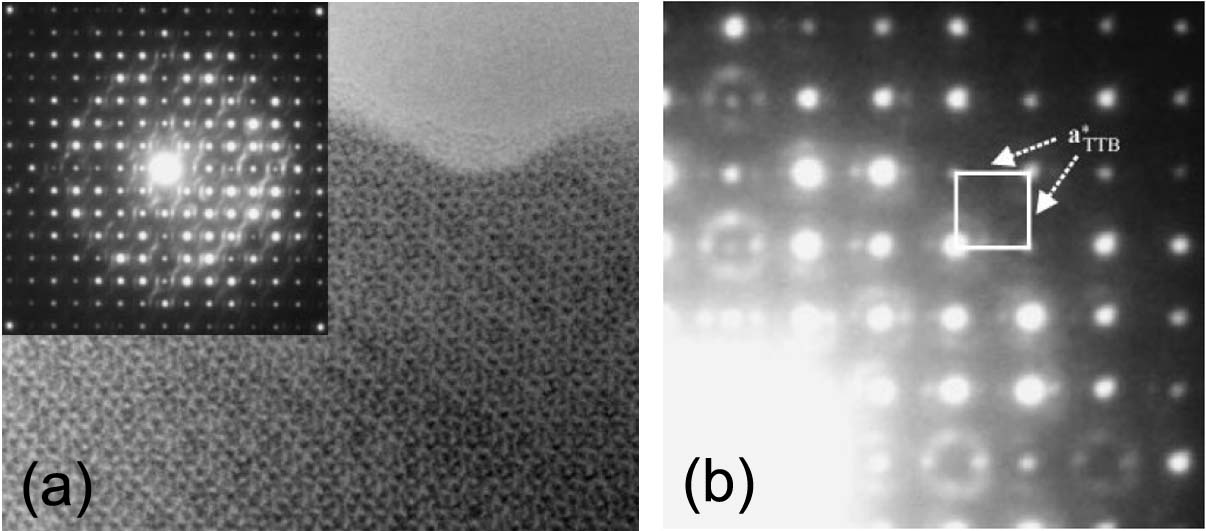=================================================================================
The pseudo-binary system Nb2O5/WO3 crystallizes in a threefold superstructure of the tetragonal tungsten bronze (TTB) type. Niobium tungsten oxides of the TTB (tetragonal tungsten bronze) type represent an excellent model system for the study of two-dimensional (2D) ordering. The underlying TTB-type substructure consists of a framework of corner-sharing MO6 octahedra (M = Nb or W) in which tunnels are oriented along the short crystallographic axis (c axis). Important structural modifications from "ideal" TTB can occur because of the existence of tunnels. The superstructure arises from a systematic occupation of the channels or tunnels with metal-oxygen strings.
For instance, some big tunnels possibly provide the diffusion paths for the oxidation and can easily be hosts of elements. Figure 2330a (a) shows the structural model of Nb8W9O47 (orthorhombic, P21212, a = 1.224 nm; b = 3.658 nm; and c = 0.394 nm) in projection onto the ab-plane. The filled circles represent the pentagonal tunnels occupied by M-O (M = Nb or W) strings. Figure 2330a (b) shows a HRTEM image of Nb4W13O47 along [001]. The inset shows a highlighted representation of the structure: the positions of octahedrally coordinated cation sites are connected by lines, while the the pentagonal tunnels occupied by cations (Nb or W) are indicated by open circles. The two distinct orientations of the TTB unit (white lines) and a unit cell (black rectangle) are outlined.
![The structural model of Nb8W9O47 in projection onto the ab-plane and (b) a HRTEM image of Nb4W13O47 along [001]](image1/3352b.jpg)
Figure 2330a. (a) The structural model of Nb8W9O47 in projection onto the
ab-plane and (b) a HRTEM image of Nb4W13O47 along [001]. [1]
Figure 2330b shows (a) a HRTEM image, (b) the HRTEM image with a simplified TTB-structural model superimposed and (c) the TTB-structural model of a niobium tungsten oxide (Nb4W13O47) of TTB-type after reacted by in situ TEM oxidation by an injected oxygen gas. The hexagonal and heptagonal tunnels appear with bright contrast at Scherzer defocus [2]. The most part of the oxidized Nb4W13O47 shows complicated and irregular framework of octahedra because of disordering by in situ oxidation. Some parts contain microdomains with regular arrangements of the TTB units that corresponds to a new intergrowth structure between ReO3 and TTB types.

Figure 2330b. (a) HRTEM image, (b) HRTEM image with the simplified TTB-structural model
superimposed and (c) TTB-structural model of Nb4W13O47. [1]
Diffuse scattering in electron diffraction can be induced by disordering or less-ordering of some atomic arrangements. For instance, two niobium tungsten oxides (Nb7W10O47.5 and Nb4W13O49) consist often of less-ordered arrangements of filled tunnels, causing the diffuse scattering in electron diffraction. Figure 2330c shows the electron diffraction patterns (along [001]) of two crystallites of Nb7W10O47.5 presenting circular diffuse scattering in different degrees, which appears around the main bright reflections of the basic TTB substructure. In Nb4W13O49 as shown in Figure 2330d, the diffuse scattering pattern is cross-shaped due to the presence of long slabs of diamond-linked pentagonal columns. Overall, the origin of the diffuse scatterings is presumably the presence of short-range order in the PC (pentagonal columns) sublattice [3], or an intermediate state of order (or called transition state [4]) between a random arrangement and a long-range ordered structure. In addition, the weak spots indicate TTB superstructures.
![The electron diffraction patterns (along [001]) of two crystallites of Nb7W10O47.5](image1/2328a.gif)
Figure 2330c. The electron diffraction patterns (along [001]) of two crystallites of Nb7W10O47.5. Adapted from [5]
![The electron diffraction patterns (along [001]) of two crystallites of Nb4W13O49](image1/2328b.jpg)
Figure 2330d. The electron diffraction patterns (along [001]) of a Nb4W13O49 crystallite. Adapted from [5]
The diffuse scatterings in electron diffractions taken from two Nb2WO8 crystallites shown in Figure 2330e also indicate the disorder among the PC (pentagonal columns) distribution within the TTB framework. Figure 2330e (a) also shows the HRTEM image where the diffraction pattern in the inset was taken.

Figure 2330e. (a) and (b) Electron diffractions in two Nb2WO8 crystallites, respectively.
Adapted from [6]
[1] M.J. Sayagués, F. Krumeich, J.L. Hutchison, Solid-gas reactions of complex oxides inside an environmental high-resolution transmission electron microscope, Micron 32 (2001) 457 - 471.
[2] Sahle, W., 1983. Electron microscopy of tungsten oxides in the range WO3 - WO2.72. Phase relations, defect structures, structural transformations and electrical conductivity. Chem. Commun. Univ. Stockholm, vol. 4.
[3] Iijima, S. & Cowley, J. M. (1977). J. Phys. Colloq. 38, 135-144.
[4] Amelinckx, S. (1992). Materials Science and Technology, Vol. 2A, Characterisation of Materials, Part. I, pp. 1-146. Weinheim: Verlag Chemie.
[5] Frank Krumeich, Order and Disorder in Niobium Tungsten Oxides of the Tetragonal Tungsten Bronze Type, Acta Cryst. (1998). B54, 240-249.
[6] Sarah K. Haydon and David A. Jefferson, Quaternary Lead-Niobium-Tungsten Oxides Based on the Tetragonal Tungsten Bronze Structure, Journal of Solid State Chemistry 161, 135 - 151 (2001).
|
![The structural model of Nb8W9O47 in projection onto the ab-plane and (b) a HRTEM image of Nb4W13O47 along [001]](image1/3352b.jpg)

![The electron diffraction patterns (along [001]) of two crystallites of Nb7W10O47.5](image1/2328a.gif)
![The electron diffraction patterns (along [001]) of two crystallites of Nb4W13O49](image1/2328b.jpg)
